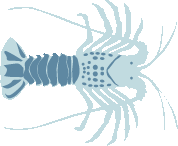Overview
The Mexican Baja California red lobster (also known as California spiny lobster) FIP is being implemented to obtain MSC Fisheries Standard certification. The interest in implementing this FIP arose from the project Fish for Good of the MSC, the results of which identified the potential for the red lobster fishery on the west coast of Baja California, Mexico to enter into a fishery improvement process. As part of the initial stages of this FIP, the fishery is also entering the MSC's ITM (In Transition to MSC Certification) program..
The target stock extends from the U.S.-Mexico border to Cedros Island along the west coast of Baja California. The southern stock is already in an MSC certified fishery, so there is a possibility that both stocks could in the future be the same Unit of Certification (UoC). The fleet is formed by licensed and registered fishermen in Baja California, who operate small boats with wire traps, organized in fishing cooperatives..
The FIP stakeholders are these fishing cooperatives, the federal and state governments, an independent consultant and an NGO. These stakeholders developed a work plan to meet the MSC pre-assessment improvement recommendations to achieve sustainable fishing status by the end of 2027.
The red lobster FIP is being implemented to obtain MSC sustainable fisheries certification. The interest in implementing this FIP arose from the MSC's Fish for Good project, the results of which identified the potential of the red lobster fishery on the west coast of Baja California, Mexico to enter into a fishery improvement process. As part of the initial stages of this FIP, the fishery is also entering the MSC's ITM (In Transition to MSC certification) program.
The target stock runs from the U.S.-Mexico border to Cedros Island along the west coast of Baja California. The stock located to the south corresponds to the fishery is already certified to the MSC standard, so there is a possibility that both stocks could in the future be the same Unit of Certification (UoC). The fleet has licensed and registered fishermen in Baja California, operating small boats with wire traps, organized in fishing cooperatives..
The FIP participants are these fishing cooperatives, federal and state governments, an independent consultant and CSOs. Who developed a work plan to meet the recommendations for improvements as a result of the MSC pre-assessment, to achieve a sustainable fishery status by the end of 2027.
El FIP de langosta roja de Baja California (también conocida como langosta espinosa de California) de México se está implementando para obtener la certificación del MSC Fisheries Standard. El interés de implementar este FIP surgió a partir del proyecto Fish for Good del MSC, cuyos resultados identificaron el potencial de la pesquería de langosta roja en la costa oeste de Baja California, México para entrar en un proceso de mejora pesquera. Como parte de las etapas iniciales de este FIP, la pesquería también está ingresando al programa ITM (En Transición a la Certificación MSC) del MSC.
La población objetivo se extiende desde la frontera entre EE. UU. y México hasta la isla de Cedros a lo largo de la costa occidental de Baja California. El stock del sur ya se encuentra en una pesquería certificada por el MSC, por lo que existe la posibilidad de que ambos stocks puedan ser en el futuro la misma Unidad de Certificación (UoC). La flota está formada por pescadores autorizados y registrados en Baja California, que operan embarcaciones menores con trampas de alambre, organizados en cooperativas pesqueras.
Los actores de la FIP son estas cooperativas pesqueras, los gobiernos federal y estatal, un consultor independiente y una ONG. Estas partes interesadas desarrollaron un plan de trabajo para cumplir con las recomendaciones de mejora de la evaluación previa del MSC para lograr un estado de pesca sostenible para fines de 2027.
El FIP de langosta roja está siendo implementado para obtener la certificación para pesquerías sostenibles del MSC. El interés de implementar este FIP surgió del proyecto denominado Fish for Good del MSC, en cuyos resultados se identificó el potencial de la pesquería de langosta roja en la costa occidental de Baja California, México para entrar en un proceso de mejora pesquera. Como parte de las etapas iniciales de este FIP, la pesquería además está entrando en el programa ITM (In Transition to MSC certifcation) del MSC.
El stock objetivo va desde la frontera entre Estados Unidos y México hasta Isla de Cedros a lo largo de la costa occidental de Baja California. El stock ubicado al sur corresponde a la pesquería ya está certificado con el estándar del MSC, por lo que existe la posibilidad de que ambos stocks puedan ser en el futuro la misma Unidad de Certificación (UoC). La flota cuenta con pescadores autorizados y registrados en Baja California, operando embarcaciones pequeñas con trampas de alambre, organizados en cooperativas pesqueras.
Los participantes del FIP son estas cooperativas pesqueras, gobiernos federal y estatal, un consultor independiente y OSC. Quienes desarrollaron un plan de trabajo para cumplir con las recomendaciones de mejoras como resultado de la preevaluación del MSC, para lograr un estado de pesquería sostenible para fines de 2027.
The Mexican Baja California red lobster (also known as California spiny lobster) FIP is being implemented to obtain MSC Fisheries Standard certification.
The California red rock lobster fishery in Baja California is at certifiable level based on the MSC standard by December 2024.
La pesquería de langosta de roja de California en Baja California se encuentra en un nivel certificable basado en el estándar MSC para diciembre de 2027.
FIP at a Glance
| 54% | 43% | 4% |
This pie chart represents completed environmental actions. Non-completed environmental actions may contain completed sub-tasks that are not illustrated here. For more information on environmental action progress visit the Actions Progress tab.
- Complete
- Incomplete
TraceabilityOther

